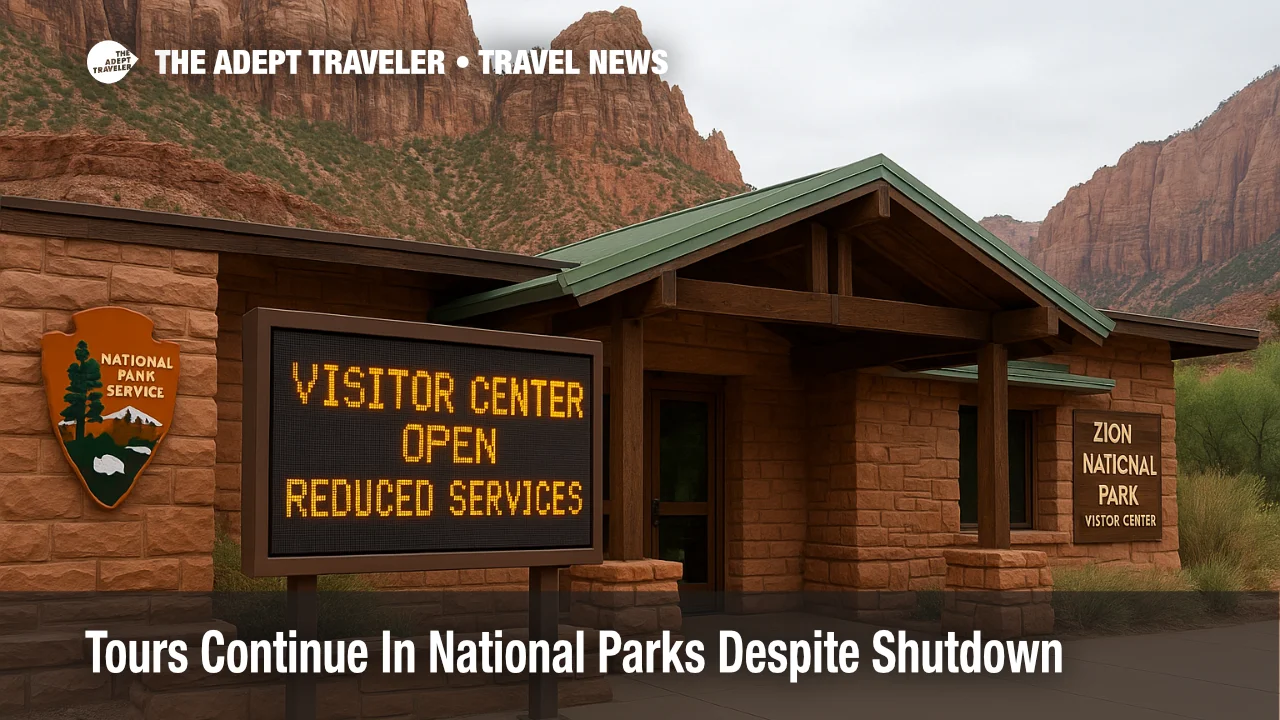Tours Continue In National Parks Despite Shutdown

Key points
- Tour operators report their national park itineraries are running as planned
- Most parks remain open under NPS contingency plans with limited services
- Utah funded visitor centers at its five national parks to remain open
- Smithsonian museums in Washington closed on October 12 due to the shutdown
- Gateway communities see mixed demand, influenced by perceptions of closures
Impact
- Park Access
- Expect open roads and trails at many parks, with fewer ranger programs, intermittent restroom service, and limited facility hours
- Itinerary Planning
- Keep bookings, build flex time, and pack water, snacks, and layers since support services may be thinner than usual
- Visitor Centers
- In Utah, state funding has kept visitor centers operating at Arches, Bryce Canyon, Canyonlands, Capitol Reef, and Zion
- Washington DC
- Plan around Smithsonian closures by checking status pages and considering private or non-federal museums
- Check Status
- Verify the specific park or museum webpage the day before travel for current alerts and operating changes
One month into the federal government shutdown that began on October 1, tour operators say national park programs are largely proceeding as scheduled. Operators reporting steady operations include Tauck, Intrepid Travel, and the Globus family of brands, with itineraries through marquee sites such as Yellowstone, Grand Canyon, Bryce Canyon, Zion, Yosemite, and Sequoia running without major alterations. The overall access picture remains favorable because most parks have stayed open to visitors, even as staffing and services are reduced under the National Park Service's (NPS) shutdown plan.
What changed, and why it matters
The NPS contingency plan aims to preserve public access where safe while pausing many non-essential services. That means open roads, trails, and open-air memorials in many units, with fewer ranger-led programs, less frequent cleaning, and limited updates to web pages and social feeds. Travelers get the benefit of continued access, though with more self-reliance required on the ground.
Concessioners are a stabilizer
Concession companies under long-term contracts, including Xanterra, have kept lodging, food, and retail running at select sites, and in some cases continued basic upkeep like restroom cleaning. That continuity has helped operators keep trips intact, especially in gateway hubs where lodging and dining remain open.
Utah stepped in on visitor centers
To reduce confusion and support trip planning, Utah's Governor's Office of Economic Opportunity is funding visitor centers at all five of the state's national parks, plus Cedar Breaks National Monument. Local public radio reports the state has been providing about $ 8,000.00 per day for these centers since October 4, improving wayfinding and services at Arches, Bryce Canyon, Canyonlands, Capitol Reef, and Zion.
Washington, D.C., demand shifted
Smithsonian museums and the National Zoo, which initially stayed open on prior-year funds, closed to the public on October 12. As those closures rolled in, operators reported stronger interest in private day tours and outdoor sightseeing. If your plans include the Mall, check the Smithsonian status page and consider non-federal museums that remain open.
Gateway communities: mixed signals
Some destinations, such as Zion's gateway in southwest Utah, report steady visitation helped by open visitor centers. Others, including parts of southwest Montana, have seen softer demand than a typical shoulder season, which local officials partly attribute to traveler confusion about what is open. When headlines blur the differences between parks, travelers sometimes cancel even where access is available. (Trade coverage gathers these reports from DMOs and operators across multiple gateways.)
Background: How shutdown access works
During a lapse in federal appropriations, the NPS implements a contingency plan that keeps many open-air areas accessible and maintains essential protection of life and property, while furloughing large portions of staff. Services such as ranger talks, school programs, and timely web updates are reduced or paused. Some states, partners, and concessioners may temporarily fund specific functions, like visitor centers or sanitation at high-traffic sites. Travelers should plan to be more self-sufficient, confirm local alerts before arrival, and expect conditions to vary by park.
Final thoughts
For most national park trips, the practical advice is simple, keep plans, verify specifics, and pack like services will be limited. Check each park's alerts page and, for D.C. itineraries, the Smithsonian status page the day before your visit. Where states or partners have stepped in, expect a more normal experience, especially around visitor information and restrooms.
Sources
- National Park Service Contingency Plan, September 2025
- National Park System Operating Status
- Many Parks Are Open During the Shutdown, But Not All
- Government Shutdown, Utah Will Help Keep National Park Visitor Centers Open
- What It Takes To Keep Utah's Zion National Park Open During The Government Shutdown
- National Park Tours Proceeding As Normal During Government Shutdown
- Intrepid Travel, U.S. Shutdown Travel Alerts
- Smithsonian Update, October 12, 2025
- How The Shutdown Affects D.C. Museums, Smithsonian Closed Oct. 12
